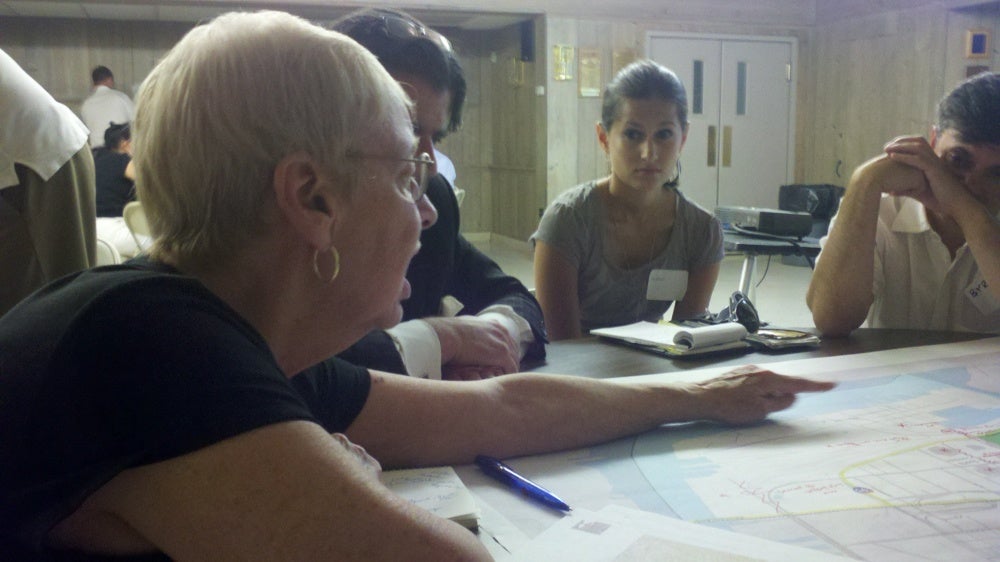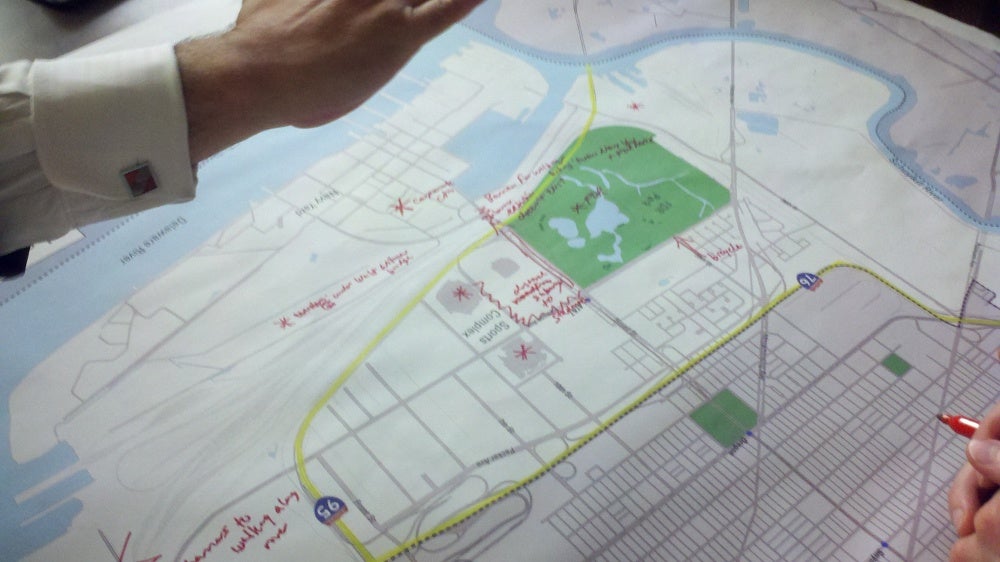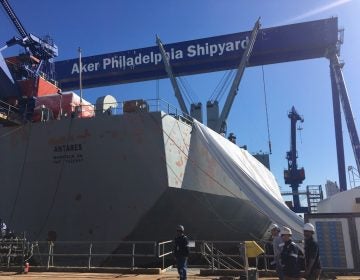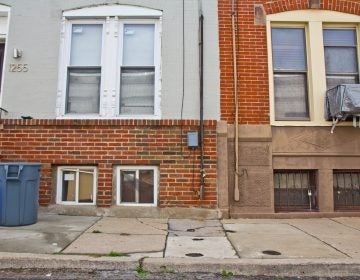A focus on jobs and transportation at public meeting on the future of Lower South Philadelphia
Public discussion began Tuesday night on a long-range comprehensive plan for the Lower South portion of Philadelphia – a section of the city dominated by industrial and entertainment uses including the Navy Yard, the port, the Food Distribution Center and the sports complexes.
Lower South also includes the Packer Park neighborhood and small portions of Grays Ferry, but community planner Jennifer Barr told those assembled at the American Swedish Museum last night, residences make up just two percent of the district’s land.
“Five-thousand people live here, but 15,000 people work in Lower South,” she said.
The city has already completed the city-wide portion of the new master plan, called Philadelphia2035. Lower South and West Park – the neighborhoods situated around west Fairmount Park – are the first of 18 district-level plans that will take a more detailed look at land use, and will then be used to guide zoning changes.
Planners have already identified key issues that need to be addressed in Lower South: Encouraging growth and mixed-use development in the Navy Yard and near the stadiums. Addressing transportation needs so that people can depend less on cars (Lower South has the highest rate of car ownership in the city, with 85.6 percent of households having cars, vs. 67.1 percent city wide, Barr said.). Improving highway access for industries and the port, and otherwise addressing industrial needs. And there’s the task of completing recreational, multi-use trails along the Delaware and Schuylkill rivers.
But just how, and where, those needs are addressed has yet to be determined, Barr told the crowd, which was seated in small working groups to discuss the facts on the ground as they are now, and their hopes and desires for the Lower South of the future.
The discussion group PlanPhilly sat with praised FDR park for the nature and recreation it offers residents, but hoped for better connections between the park and the rest of the area. Stacy Thomas, who lives in Point Breeze, said she’d like to be able to ride her bike to the park more easily. John Gattuso, senior vice president and regional director at Liberty Property Trust, the group working with the Philadelphia Industrial Development Corporation to re-develop the Navy Yard, lamented that the park is “relatively isolated from the South Philadelphia community” and from the emerging multi-use riverfront trails on both the Schuylkill and Delaware rivers. Gattuso, who has been part of the effort to improve the Schuylkill waterfront, said it would be wonderful if people could walk from Bartram’s Gardens to FDR Park.
There was also discussion that there might be space for new homes in the Lower South of the future – perhaps in part of what is now Sunoco land, where tanks have been removed and environmental remediation is taking place.
But most of the talk centered on two themes: Public transportation and jobs.
Whitman Resident Bootsie Cullen considered the huge concrete expanse of the sports complex parking lots, and suggested that during rush hours or at times when no events are being held, they could serve another use: A park-and-ride for public transportation. Her family members who live in the suburbs can park their cars for cheap, hop a train to the city and “leave the driving to someone else,” she said, and Lower South and other city residents could benefit from the same option.
Byron Comati, SEPTA’s director of strategic planning and analysis, said that park and rides do add value.
Gattuso brought up a transportation vision from the Navy Yard’s master plan: A 75-foot deep transit tunnel dug from the Navy Yard under the Delaware River to Gloucester County, NJ. Gloucester County is growing fast, Gattuso said, but right now, getting back and forth between there and the city means an indirect route over one of the existing bridges. A direct connection linking SEPTA and New Jersey’s PATCO service would help underscore the city’s role as center of a major metropolitan region, he said.
On the Philadelphia side, the tunnel would connect to the Broad Street line – an expansion to the Navy Yard has been talked about for some time, and was part of the broader city-level master plan discussion.
After the session, Gattuso explained that from the Navy Yard’s point of view, part of the beauty of such a direct connection to Philadelphia and New Jersey is that more Navy Yard land would be freed up for industry or other higher forms of development than parking lots. The fewer people who drive there, the fewer parking spaces are needed, he said.
The Navy Yard Master Plan, completed in 2003, looks out 15 years, he said.
During the discussion, people around the table were excited about the tunnel idea, and took it further – couldn’t the Broad Street subway line include another stop closer to the stadiums, curve to the Navy Yard and then continue on the whole way to the airport?
SEPTA’s Comati said these kind of big ideas were on target. Could the Broad Street line really be extended to the airport? It could, he said after the session. But there are already transit routes to the airport, and there is hope for a light-rail system that would eventually follow the Delaware River, and that could potentially be extended the whole way to the airport. His point was that more than one new route to the airport is probably too duplicative, and so it was best to focus on one or the other.
At an earlier public input session focused on the city-wide comprehensive plan – a broader view than the more detailed district-level plans – Comati said that in order for the subway line to reach the Navy Yard, residential development needed to be included in the Navy Yard’s future. He estimated then that the 1.5 mile extension would cost between $500 million and $750 million.
SEPTA would be interested in hooking the line up with the tunnel Gattuso spoke of. He said a connection over the river – in other words, a bridge – is also a potential solution. When asked who would pay for the tunnel, Comati said “everybody would have to throw money in” to such a large project.
Gattuso said he didn’t have a cost estimate, but agreed it would be a very large number. That shouldn’t stop Philadelphia from trying to make it happen, he said.
All heads around the table were nodding at the suggestion that goals for any lands no longer used by Sunoco in the future, as well as the Navy Yard, should include job creation.
Gattuso and Cullen got into a debate about whether the focus should be on distribution or manufacturing.
Gattuso said that not only does Lower South land offer relatively easy access to rail, ship, highways and the airport, but Philadelphia offers distributors something that few other areas can match: A large pool of relatively inexpensive labor. When TJ Maxx located a huge distribution facility here, he said, part of the attraction was that even though building here would cost more than in another Pennsylvania location it was considering, labor would cost less – even though the labor in the other location was non-unionized.
It’s precisely the wages distribution workers get that made Cullen say the same amenities should be used to lure manufacturing jobs here. “Why can’t we have more green industry?” she asked. Gattuso said there is more demand for distribution space than industrial right now. “You can’t get gold if you only try for silver,” Cullen said.
The city planners at the table reined in the discussion, and Cullen and Gattuso agreed that the map of the area the planners were making notes on should call for some sort of industrial land use.
This discussion table’s map and those of the others in the room will be mingled into a single map with suggested land uses, improvements, areas of change and areas of stability by planning staff. In about a week, it will be posted on the Philadelphia2035 website, Barr said. The website also contains maps and other information about each of the 18 districts, including the schedule of when the planning commission will tackle district-level planning for each cluster of neighborhoods.
There will be two other public input sessions on the Lower South plan. The yet-to-be-determined dates, times and locations will also be posted on the website. At the next meeting, sometime in September, participants will help planners select several “opportunity zones” within Lower South – places where more detailed planning efforts should be focused. At the third meeting, to be held in November, staff will go through a draft of the recommendations for Lower South. That draft, with changes made in part based on public comment, will be presented in a public meeting to the Planning Commission, she said.
Reach the reporter at kgates@planphilly.com.
WHYY is your source for fact-based, in-depth journalism and information. As a nonprofit organization, we rely on financial support from readers like you. Please give today.









